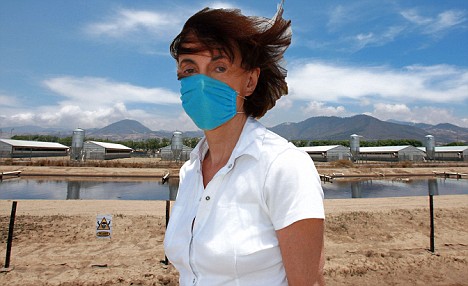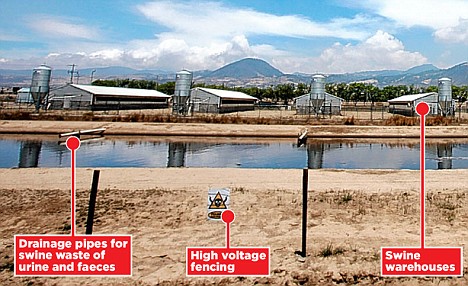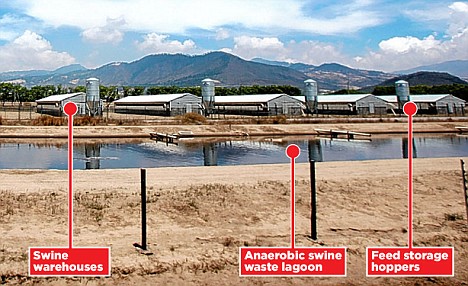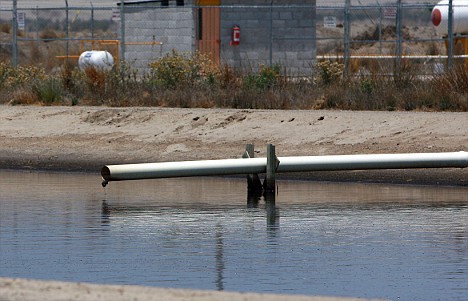'The smell is so awful that I start to vomit': Is this farm the Ground Zero of swine flu?
By
Sharon Churcher In La Gloria, Mexico
Last updated at 12:49 AM on 03rd May 2009
Barricaded with double-perimeter high-voltage electric and razor-wire fences and protected by security lights and locked gates, the ominous-looking compound in the high plains five hours east of Mexico City might be mistaken for a prison – except that the inmates are pigs.
An unobtrusive sign announces that I have arrived at Site 8-2, a gigantic factory farm near the isolated hamlet of La Gloria where residents claim they are living at Ground Zero of the swine flu epidemic.
The desert wind is rank with a nauseating stench. Eight hangar-style buildings house 7,200 sows and their piglets but the complex is eerily silent except for an occasional grunt.

Mail on Sunday reporter Sharon Churcher at the site wearing a face mask
It is part of a chain of some 16 farms in this region that are owned by a Mexican company, Granjas Carroll de Mexico (GCM), in partnership with US-based Smithfield Foods, which, as the world’s largest pork producer, runs adverts in Britain about how it provides ‘good food in a responsible way’.
Last month, however, after hundreds of La Gloria villagers complained of flu-like symptoms, a five-year-old boy in the hamlet, Edgar Hernandez, was confirmed to be suffering from the virulent new strain of swine flu, H1N1.
Mexican officials are downplaying the epidemic, revising their estimate of deaths from the virus to 101 on Friday, a sharp drop from an earlier figure of 176, but the disease has taken a higher toll here than in any other country. And activists in La Gloria claim the pig farms are a fetid crucible for the new virus.
The company’s farming practices include burying dead pigs to rot in ‘biodigester’ containers. And pig urine and faeces are flushed into huge open-air pits, adjoining miles of cropland, which GCM disarmingly calls ‘lagoons’.
‘These farms are a disgrace,’ a subsistence farmer, Guadalupe Serrano Gaspar, 66, who is one of the leaders of the protests, said. ‘We believe they pollute the air and our groundwater and that they are directly responsible for this virus.’
Though environmentalists have criticised similar practices in the US, the La Gloria activists have not produced any scientific evidence of pollution in their little town (population 3,000).

Nauseating: The vast factory farm housing thousands of pigs that is at the centre of the flu outbreak
Indeed, when I requested a tour of the pig sheds, GCM’s director general, Victor Ochoa, politely refused, saying that it is people who are a threat to pigs and not the other way round.
‘Pigs cannot transmit viral infections to humans,’ he said. ‘But it is a scientific fact that swine can pick up the flu virus from humans. How do I know you don’t have the flu? Or you could be carrying foot-and-mouth disease that will infect my pigs.’
Some scientists sharply disagree, however. They argue that in damp, cramped conditions, swine viruses may mutate into contagious new strains.
'We are afraid they have polluted the wells'
British microbiologist Professor Hugh Pennington said: ‘It is entirely possible to transfer the flu virus both ways between species. Flu itself probably got into pigs from humans during the big pandemic in 1918. So it’s possible this [epidemic] is the pigs’ revenge.’
Experts are divided on the manure-filled lagoons. Professor Pennington said: ‘These lagoons and the accompanying smell simply mean there are lots of pigs around. You would need direct and prolonged contact with an animal with the virus to contract it.’

'Pig waste lagoons are a great danger to human health'
But Dr Michael Greger, director of public health and agriculture at the US Humane Society, said: ‘There is evidence that flies landing on animal waste can spread the flu virus for miles around.
‘Pig waste lagoons are a great danger to human health. There are many ways – the wind for example – that illness can be spread from them. In the case of this current swine flu, the virus could easily escape from factory farm facilities.’
Sows at weaning farms such as Site 8-2 live with their piglets in cages so small that they have room to lie down but not turn around, a company spokesman said.
They stand on grates over a water-filled pit. Once a week, the urine and manure is flushed into the lagoon, which has a clay lining that the company says prevents any seepage.
Half a mile away, I found Site 8-3, where sows are transferred after their piglets are weaned. Here 16,200 of them were being fattened last week for slaughter.
There are 18 sheds, connected in a similar arrangement to Site 8-2, to an outdoor cesspit. Behind the pit, there was another trench, the size perhaps of one-and-a-half football fields.
Clouds of dirt, whipped by the wind, blew in my face and the smell was so overpowering I started to vomit. Ventilation pipes rose from a concrete slab, covering the ‘biodigester’ into which the dead pigs allegedly are dumped.
A goatherd, Jose Benitez, who was tending his flock with his eight-year-old grandson on the track to the farm said: ‘When pigs get sick and die, they bury them there. I cannot handle the smell.
‘I do not think this is a good idea with all the illness that is around.’

Flushed out: A waste pipe leaks into a 'lagoon'
Edgar Hernandez was among the La Gloria residents – over half the population, by some estimates – who began to suffer from sore throats, fevers and other flu-like conditions in an outbreak that began about three months ago.
Mexican authorities say they took samples of mucus from 30 victims but only Edgar’s was positive for swine flu. They claim the remaining victims had common flu or pneumonia. And some villagers point out that illness and premature deaths are not uncommon in La Gloria because of their impoverished lives and lack of medical care.
Despite the pork company’s claims that it has helped the local economy, its employees must meet a minimum requirement of the equivalent of A-levels and only a handful of people from La Gloria have obtained jobs at its farms.
Most residents eke out a living from the stony soil, which they till with horse-drawn ploughs. Many get around in carts drawn by scrawny donkeys.
A peasant called Maria said she has faith in the pork company. Standing outside her one-room hut, where she cooks on an open fire and sleeps on a mat, she said her seven-month-old son, Juan, had died suddenly after contracting a hacking cough. ‘The doctor said it was pneumonia,’ she said.
She proudly showed me the pig she is raising in the rubble behind her shanty. ‘How can you catch flu from a pig?’ she asked nervously.

Cramped: Pigs pressed up against
each other in a Mexican pig farm
But one of her neighbours, Estefan de la Cruz, blamed the pig farms for swarms of flies that he and other residents claim have infested the village.
‘We get lots of flies. The government sent trucks here yesterday to fumigate the village,’ he said.
‘This company tips the s*** from its pigs into the ground. When it is really windy, the smell of pig s *** is very strong and we are afraid that they have polluted the wells from which we get our water.’
A company spokesman said: ‘Our lagoons do not generate any pollution. The clay with which we line them gives them a hardness equivalent to cement. They are waterproof – like a ceramic mug.’
The company added in a statement that it follows ‘industry practices’ for animals that die from ‘stress or old age’.
The bodies usually are disposed of in ‘biodigesters – a closed cement container that has a chimney. Substances like enzymes are added to accelerate biodegradation,’ the statement says.
The company says carcasses are also used for compost.
‘This is not very pleasant to look at but it deals with a
natural life cycle...properly and safely,’ the statement
adds.